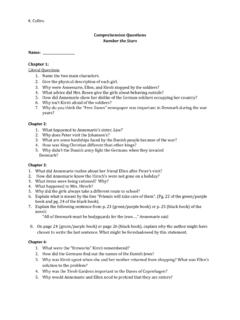Transcription of Alan S. Kaufman, PhD, & Nadeen L. Kaufman, EdD
1 KTEA -3 Kaufman Test of Educational Achievement, Third Edition Parent Report Alan S. Kaufman, PhD, & Nadeen L. Kaufman, EdD Name:Sample Report 1 Test Date:05/20/2014 Examinee ID:11111 Form:ABirth Date:01/10/2005 Examiner Name:Sample ExaminerAge:9:4 Testing Site:N/AGender:MaleCurrent Grade(or Highest GradeCompleted):3 Reason for Referral:Medication:Copyright 2014 NCS Pearson, Inc.
2 All rights , the PSI logo, PyschCorp and KTEA are trademarks in the and/or other countries of Pearson Education, Inc., or its affiliate(s).TRADE SECRET INFORMATIONNot for release under HIPAA or other data disclosure laws that exempt trade secrets from disclosure.[ / RE1 / QG1 ]This test includes subtests to measure listening, speaking, reading , writing, and mathematics skills. The following is adescription of each subtest that was administered to your child. Subtest DescriptionsReadingLetter & Word RecognitionThe student identifies letters and reads grade-appropriate Word DecodingThe student pronounces made-up ComprehensionThe student reads symbols, words, sentences, and passages appropriate to his or her gradelevel, and then responds to comprehension VocabularyThe student reads a word in the context of a picture (early items) or a sentence (lateritems)
3 , and then selects a word that means the same FluencyWord Recognition FluencyThe student reads as many words as possible within a time FluencyThe student reads as many made-up words as possible within a time reading FluencyThe student has two minutes to silently read simple questions, and circle yes or no to Concepts & ApplicationsThe student solves math problems that relate to real life situations and assess skills such asnumber concepts, arithmetic, time and money, and ComputationThe student solves written math calculation FluencyThe student writes answers to simple arithmetic problems within a time limit.
4 Problemsinclude addition and subtraction, and for later items, multiplication and ExpressionThe student hears a story presented with pictures in a booklet and completes the story bywriting letters, words, sentences, and (for students in grade 1 or higher) an student writes single letters and spells words dictated by the FluencyThe student writes simple sentences, each one describing a different picture, within a LanguageListening ComprehensionThe student listens to sentences or passages, and then responds to ExpressionThe student says a sentence to describe a photograph.
5 Later items require the use ofspecific words or FluencyThe student has 60 seconds to say as many words as possible that belong to a particularcategory, such as animals or ProcessingPhonological ProcessingThe student responds orally to items that require manipulation of the sounds within Naming FacilityThe student names pictured objects as quickly as Naming FacilityThe student names upper- and lowercase letters as quickly as -3 Parent Report, Age-Based Norms 1111105/20/2014, Page 2 Copyright 2014 NCS Pearson, Inc.
6 All rights subtests described above are grouped by subject area into composite scores. The graph below shows your child'sperformance on each composite compared to a normal distribution of scores from peers of the same of Performance by CompositeReadingOral LanguageOral FluencyExpressionComprehensionMathWritte n LanguageSound-SymbolDecodingReading UnderstandingOrthographic ProcessingReading FluencyAcademic SkillsBatteryAcademic Fluency406070901001201301501605080110140 KTEA -3 Parent Report, Age-Based Norms 1111105/20/2014, Page 3 Copyright 2014 NCS Pearson, Inc.
7 All rights graph below shows your child's performance on each subtest compared to a normal distribution of scores from peers ofthe same of Performance by SubtestReading ComprehensionLetter & Word RecognitionWritten ExpressionObject Naming FacilityListening ComprehensionOral ExpressionAssociational FluencyPhonological ProcessingMath Concepts & ApplicationsMath ComputationSpellingLetter Naming FacilityNonsense Word DecodingSilent reading FluencyMath FluencyWriting FluencyReading VocabularyWord Recognition FluencyDecoding Fluency406070901001201301501605080110140 KTEA -3 Parent Report, Age-Based Norms 1111105/20/2014, Page 4 Copyright 2014 NCS Pearson, Inc.
8 All rights following activities can be used at home to support learning in core reading , writing, math, and/or oral language areas. Grades: 3 - 5 1. Engage your child in writing frequently and for a variety of purposes, such as writing thank you notes, birthday cards,holiday cards, and invitations. 2. Have your child write shopping lists and search and check off needed items, or list amounts needed on a preprinted list. 3. Help build editing skills in a fun way. For example, provide your child with an editing checklist (self-created or online)and ask him or her to assume the role of editing inspector.
9 As he or she reviews each sentence, you can read the requirements,such as "Is there ending punctuation?" or "Do all sentences begin with a capital?" 4. Build sequencing skills that are important to writing by cutting apart comic strips, mixing them up, and having your childarrange them to tell a logical story. 5. Remind your child that writing is a process that involves steps. Let him or her see you draft something and, later, showhim or her the refined piece. Alternatively, save drafts of his or her writing to show later and compare it to the final productso that your child can see how his or her writing developed.
10 Grades: 3 - 5 1. Play the word game "Hangman" with your child. 2. Create opportunities for your child to practice spelling skills by asking him or her to help you spell a word, such as thename of a teacher, the name of his or her favorite game, or the name of a character on TV. 3. Provide opportunities for your child to alphabetize. For example, cut a weekly spelling word list into strips and have himor her put the strips in alphabetical order. Alternatively, use real world activities, like shopping, as an opportunity to haveyour child alphabetize.















